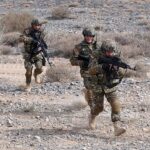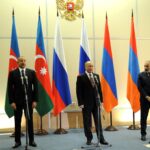It has been almost a year since the European Union and the United States enacted sanctions against Belarus due to the government’s crackdown on the protests following the country’s presidential elections. However, Western measures have not had any efficient impact as they have fallen short in ending the authoritarian regime.
Lukashenko has long played Russia and the West against each other in a manner that provided him with a degree of international respect. However, the Western ostracization of Belarus has pushed Lukashenko unprecedentedly closer to Moscow. Russia has been steadily expanding its leverage over Minsk since the 2020 protests, most notably when the Kremlin sent Belarus a 1.5 billion USD loan and agreed to deepen trade linkages. However, Moscow’s support has come with strings attached, and the patron-client relationship which the two countries have entered has become a new opportunity for the Kremlin to garner political and economic control over Minsk and to turn Belarus into its military place d’armes.
Belarus in the Russian orbit
Russia has always been a powerful economic and political partner for Belarusian President Alexander Lukashenko, supporting the current authoritarian regime for 27 years. However, the relationship between the two countries has always been unstable. Belarus was never interested in being part of ‘Ruskiy Mir’ (the Russian World) and even “flirted” with the West to antagonize Moscow. The Belarusian government has even removed pro-Russian figures from the country’s security apparatus.
In 2014, when Russia started its military campaign against Ukraine, Lukashenko remained neutral and refused to recognize Russian claims on the Crimean Peninsula. The Belarusian president emphasized that he would not permit any attacks against Ukraine from Belarus proper. Lukashenko also showed readiness to act as a mediator between Russia and Ukraine and to host peace negotiations in Minsk aimed at diffusing the conflict. The position of neutrality in the conflict paid off, as it boosted Lukashenko’s international image, with Minsk becoming a hub for Ukraine-Russia air traffic following the 2015 ban of all direct flights between Moscow and Kyiv.
August 2020, however, marked the dawn of a new period, in which Lukashenko violently cracked down on nationwide protests over a rigged presidential election. The Kremlin directly assisted Lukashenko to effectively overcome months of street rallies and weather sanctions. Putin also promised the Belarusian leader military assistance if things went “out of control.” Despite such guarantees, Russian aid to Lukashenko has not come without a price. Having been isolated by the West, the Belarusian dictator has no choice but to remain within the Russian orbit and play the game according to the Kremlin’s rules.
While Lukashenko has sided with Russia, Ukraine has broadly aligned itself with the West. Over the past year, Ukrainian President Volodymyr Zelensky has become increasingly critical of Lukashenko. In July, Kyiv joined the West in restricting flights from entering the Belarusian airspace following the forced-landing of a Ryanair plane in May, an incident that has been branded as an act of “state-sponsored piracy”. In the meantime, Lukashenko stated that Belarusian national airline Belavia would launch flights to Crimea, a statement that indicated Minsk’s readiness to recognize Russia’s illegal annexation of the Ukrainian territory. Lukashenko has also accused Kyiv of being involved in “foreign plots” aimed at destabilizing Belarus through the use of militants that had been trained in Ukraine.
Russia’s new military district
An invasion via Belarus has always been part of Ukraine’s fears. Nevertheless, the threat has become more real as isolated Minsk’s dependence on Moscow has skyrocketed. Lukashenko and Russian President Vladimir Putin have conducted five rounds of negotiations on the so-called Union State, a project aimed to deepen political and economic integration between Russia and Belarus. On September 9, after meeting with Putin for the fifth time in 2021, a 28-point road map was introduced with the goal to bind the two countries closer together. Lukashenko expressed his interest in closer integration with Russia, even though it is apparent that the integration project will limit Minsk’s independence.
Belarus has emerged as a new security threat to Ukraine as Russia has been effectively cementing a permanent military presence in the country. So far, Moscow and Minsk have conducted a record number of joint military drills in 2021. Additionally, in August, a new joint training base was established in the town of Grodno near the border with Poland and Lithuania.
On September 12, Lukashenka has announced plans to deploy Russian S-400 air defense systems near northern districts of Ukraine “to protect his country’s border with Ukraine.” The statement came after Moscow held one of its largest joint exercises with Belarus on Ukraine’s northern flank in September, involving around 200,000 troops. The Belarusian dictator also highlighted that the defense system was part of a $1 billion arms package agreed upon during the September summit in Moscow.
The announcement on the relocation of the defense system raised fears in Ukraine, as it can be interpreted as an indicator of the Kremlin’s pre-war preparations. The defense systems would be needed for protecting Russian troops in the case of a sudden invasion from Belarus. Russia has already annexed Ukraine’s Crimean Peninsula in the south and occupied the Donetsk and Luhansk districts in the east. With little progress towards conflict resolution, the prospect of a possible hybrid war from the north represents a major challenge to the Ukrainian government.
Lukashenko’s recent statement on the deployment of Russian defense systems to the Ukrainian border suggests progress has been made in Russia’s stealth takeover of Minsk, but the fact that Belarus might be turning into a new front in Putin’s ongoing hybrid warfare against Ukrainian sovereignty and territorial integrity.

